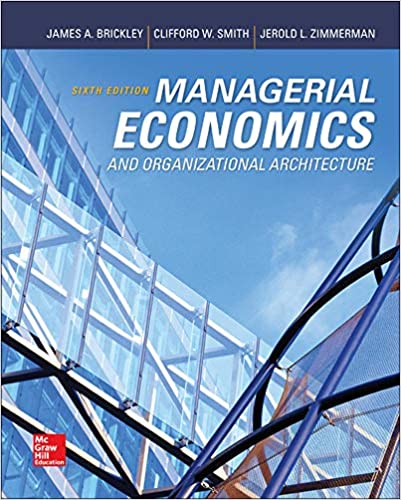
Managerial Economics & Organizational Architecture 6th Edition by James Brickley , Clifford Smith ,Jerold Zimmerman
Edition 6ISBN: 978-0073523149
Managerial Economics & Organizational Architecture 6th Edition by James Brickley , Clifford Smith ,Jerold Zimmerman
Edition 6ISBN: 978-0073523149 Exercise 23
ANALYZING MANAGERIAL DECISIONS: Favoring a Government Ban on Advertising
Cigarette manufacturers were among the first companies to advertise extensively on television. Older people today can still hum the heavily televised jingle, "Winston tastes good like a cigarette should," and recall the Old Gold Dancing Cigarette Pack-an oversized dancing cigarette package with shapely female legs. They can also remember beautiful women with black eyes as they testified that "Tareyton smokers would rather fight than switch." John Wayne and other movie stars appeared in commercials to endorse cigarettes. Cigarette companies were the major sponsors for many popular television shows. The companies also paid to have cigarettes included in the actual programs. In 1962, the cartoon characters Fred and Wilma Flintstone were shown smoking Winston cigarettes.
The U.S. federal Government banned television advertising of cigarettes starting in 1971. Interestingly the ban was supported by the leading cigarette manufacturing companies even though they had advertised heavily on television since the 1940s.
Design a simple two-company game that illustrates why it might have been in the economic interests of the cigarette companies to support the ban. In designing the game, assume that there is no regulation and that the two firms simultaneously choose between advertising and not advertising. Display your hypothetical payoffs in strategic form (see Figure 9.1) and highlight the Nash equilibrium. Explain the intuition for why the firms in your example would favor regulation to ban advertising.
Figure 9.1: Strategic Form
In this case, Boeing and Airbus individually choose and simultaneously submit a bid price for 10 planes. They can submit either a high price or a low price. If one company bids high and the other bids low, the order goes to the low bidder; if both companies submit the same bid, they split the order. This diagram presents the possible profits from the interaction in strategic form (normal form). Each cell presents the payoffs (in millions of dollars) of a pair of decisions. The entry on the lower right of each cell is the payoff for Airbus, whereas the entry on the upper left is for Boeing. Both firms have a dominant strategy (shaded cell)-submit a low price.

Cigarette manufacturers were among the first companies to advertise extensively on television. Older people today can still hum the heavily televised jingle, "Winston tastes good like a cigarette should," and recall the Old Gold Dancing Cigarette Pack-an oversized dancing cigarette package with shapely female legs. They can also remember beautiful women with black eyes as they testified that "Tareyton smokers would rather fight than switch." John Wayne and other movie stars appeared in commercials to endorse cigarettes. Cigarette companies were the major sponsors for many popular television shows. The companies also paid to have cigarettes included in the actual programs. In 1962, the cartoon characters Fred and Wilma Flintstone were shown smoking Winston cigarettes.
The U.S. federal Government banned television advertising of cigarettes starting in 1971. Interestingly the ban was supported by the leading cigarette manufacturing companies even though they had advertised heavily on television since the 1940s.
Design a simple two-company game that illustrates why it might have been in the economic interests of the cigarette companies to support the ban. In designing the game, assume that there is no regulation and that the two firms simultaneously choose between advertising and not advertising. Display your hypothetical payoffs in strategic form (see Figure 9.1) and highlight the Nash equilibrium. Explain the intuition for why the firms in your example would favor regulation to ban advertising.
Figure 9.1: Strategic Form
In this case, Boeing and Airbus individually choose and simultaneously submit a bid price for 10 planes. They can submit either a high price or a low price. If one company bids high and the other bids low, the order goes to the low bidder; if both companies submit the same bid, they split the order. This diagram presents the possible profits from the interaction in strategic form (normal form). Each cell presents the payoffs (in millions of dollars) of a pair of decisions. The entry on the lower right of each cell is the payoff for Airbus, whereas the entry on the upper left is for Boeing. Both firms have a dominant strategy (shaded cell)-submit a low price.

Explanation
As per the question, the government has ...
Managerial Economics & Organizational Architecture 6th Edition by James Brickley , Clifford Smith ,Jerold Zimmerman
Why don’t you like this exercise?
Other Minimum 8 character and maximum 255 character
Character 255


